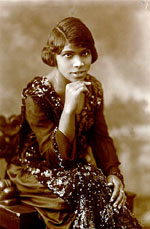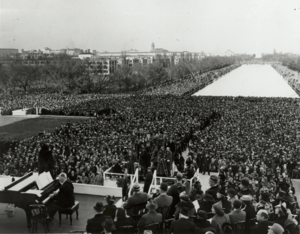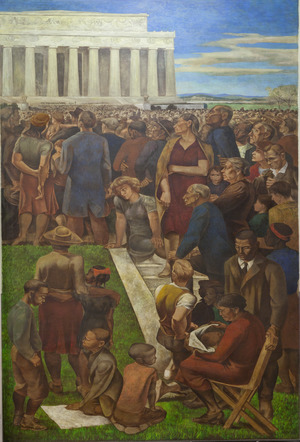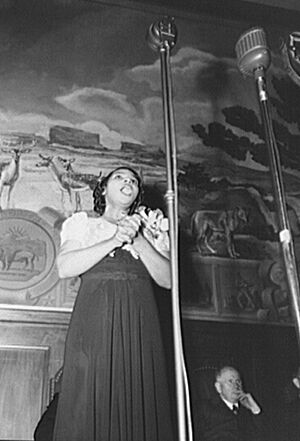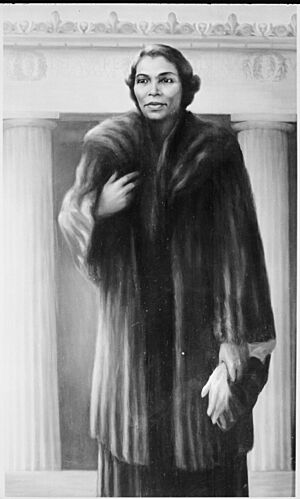Marian Anderson facts for kids
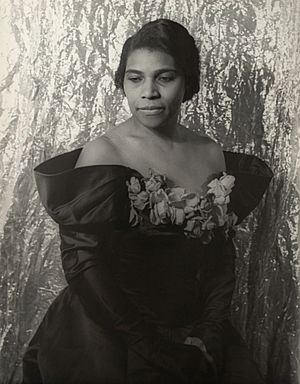
Marian Anderson (born February 27, 1897 – died April 8, 1993) was an amazing American singer. She was known for her deep, rich voice, called a contralto. Marian sang many types of music, from grand opera to soulful spirituals.
From 1925 to 1965, she performed with famous orchestras in big concert halls across the United States and Europe. Marian Anderson was a very important person in the fight against racial prejudice for African-American artists in the mid-1900s.
Contents
Early Life and Music
Marian Anderson was born in Philadelphia on February 27, 1897. Her father, John Berkley Anderson, sold ice and coal. Her mother, Annie Delilah Rucker, had been a schoolteacher in Virginia. She cared for young children to earn money.
Marian was the oldest of three sisters. Her sisters, Alyse and Ethel, also became singers. Ethel's son, James DePreist, grew up to be a famous conductor.
Marian's family was very religious and active in the Union Baptist Church. Her aunt Mary, who loved music, encouraged Marian to join the junior church choir when she was six. Marian often sang solos there. Her aunt also took her to many concerts and music events. Marian said her aunt was the reason she decided to become a singer.
From a young age, Marian sang at local events. She would often earn 25 or 50 cents for a few songs. By her early teens, she was making four or five dollars per performance. This was a lot of money back then! At age 10, Marian joined the People's Chorus of Philadelphia. She was often a soloist there.
When Marian was 12, her father passed away after an injury. He was only 37. Marian and her family moved in with her grandparents. Her grandfather had been born into slavery and became free in the 1860s. He and Marian became very close before he passed away a year later.
Learning to Sing
Marian went to Stanton Grammar School and finished in 1912. Her family could not afford music lessons or high school. But Marian kept singing wherever she could and learned from anyone willing to teach her.
As a teenager, she stayed active in her church's music groups. She also joined the Camp Fire Girls, which gave her some musical chances. Eventually, her church and the black community in Philadelphia raised money for her. This allowed her to take singing lessons and attend South Philadelphia High School. She graduated in 1921.
After high school, Marian tried to get into an all-white music school, the Philadelphia Musical Academy. But she was turned away because she was black. The person at the admissions desk simply said, "We don't take colored."
Marian then studied singing privately in Philadelphia. She got financial help from the black community. Her high school principal introduced her to Giuseppe Boghetti, a singing teacher. Marian sang "Deep River" for him, and he was so moved he cried. Boghetti arranged a concert for her in New York City in 1924. It was not very successful.
In 1923, she made two recordings: "Deep River" and "My Way's Cloudy."
Rising to Fame
In 1925, Marian got her first big break. She won a singing competition held by the New York Philharmonic orchestra. As the winner, she got to perform with the orchestra on August 26, 1925. Her performance was a huge hit with everyone.
Marian continued her studies and got a manager, Arthur Judson. She performed many concerts in the United States. But sadly, racial prejudice often held her career back. She first sang at Carnegie Hall in 1928.
Studying in Europe
In 1929, Marian sang in Chicago. Two people from the Rosenwald Fund, an organization that helped people, were in the audience. They encouraged Marian to apply for a scholarship. She received $1500 to study music in Berlin, Germany.
Marian went to Europe and studied with Sara Charles-Cahier. Then, she went on a very successful singing tour across Europe. In 1930, she visited Scandinavia. There, she met Kosti Vehanen, a Finnish pianist who became her regular accompanist and vocal coach for many years.
She also met the famous composer Jean Sibelius in Helsinki. He was so impressed by her singing that he invited her to his home. Sibelius told Marian that she had truly understood the "Nordic soul" with her voice. They became good friends, and Sibelius even changed and wrote songs just for her.
In 1933, Marian made her European debut in London. She was greatly praised. In the early 1930s, she toured Europe, where she did not face the same prejudice she did in America. She became a favorite of many European conductors and composers. In 1935, the famous conductor Arturo Toscanini told her she had a voice "heard once in a hundred years."
Tours in America
In 1934, a new manager named Sol Hurok convinced Marian to come back and perform in America. In 1935, she gave another concert in New York City. This time, it received excellent reviews. For the next four years, she toured both the United States and Europe.
European opera houses offered her roles, but Marian turned them down. She felt she didn't have enough acting experience. However, she did record many opera songs in the studio, and they became very popular.
Even with all her success, Marian still faced Jim Crow laws in the 1930s. These laws enforced racial segregation. She gave about 70 concerts a year in the U.S., but some hotels and restaurants still refused to serve her. Because of this, the famous scientist Albert Einstein, who supported racial equality, often hosted Marian at his home. The first time was in 1937 when she couldn't get a hotel room while performing near Princeton University. She stayed with him many times until he died in 1955.
The Lincoln Memorial Concert
In 1939, during a time of racial segregation, a group called the Daughters of the American Revolution (DAR) refused to let Marian sing in their hall in Washington, D.C. They would not allow a mixed-race audience. This event brought Marian into the international spotlight.
With help from First Lady Eleanor Roosevelt and President Franklin D. Roosevelt, Marian performed a famous outdoor concert. It was on Easter Sunday, April 9, 1939, on the steps of the Lincoln Memorial in Washington, D.C. She sang for more than 75,000 people, and millions more listened on the radio.
After the DAR's refusal, thousands of their members, including Eleanor Roosevelt, quit the organization. Roosevelt wrote that she completely disagreed with their decision. She felt they missed a chance to show leadership.
Two months later, Eleanor Roosevelt spoke on national radio. She presented Marian with the 1939 Spingarn Medal for her great achievements. A documentary film about the concert was chosen for the National Film Registry in 2001. The radio coverage of the event was also selected for the National Recording Registry in 2008.
Mid-Career Highlights
During World War II and the Korean War, Marian Anderson sang for soldiers in hospitals and at military bases. In 1943, the DAR finally invited her to sing at their Constitution Hall. This time, it was for a mixed audience as a benefit for the American Red Cross. Marian said she felt no different singing there than anywhere else. She was just happy to perform in a beautiful hall. However, the local school board still wouldn't let her use high school auditoriums in Washington, D.C.
Singing for Millions
On June 15, 1953, Marian was the main performer on The Ford 50th Anniversary Show. This show was broadcast live on two major TV networks. She sang "He's Got the Whole World in His Hands" and closed the show with "Battle Hymn of the Republic." About 60 million people watched the program. A TV critic later called it a "landmark in television."
First at the Metropolitan Opera
On January 7, 1955, Marian Anderson made history. She became the first African-American person to sing with the Metropolitan Opera in New York. She played the part of Ulrica in an opera called Un ballo in maschera. Marian said she trembled when the audience applauded before she even sang a note.
Even though she never sang with the company again, she was named a permanent member. The next year, her autobiography, My Lord, What a Morning, became a bestseller.
Presidential Events and Goodwill Tours
In 1957, Marian sang for President Dwight D. Eisenhower's inauguration. She also toured India and the Far East as a goodwill ambassador for the U.S. State Department. She traveled over 35,000 miles in 12 weeks, giving 24 concerts. After this, President Eisenhower made her a delegate to the United Nations Human Rights Committee.
On January 20, 1961, she sang for President John F. Kennedy's inauguration. In 1962, she performed for President Kennedy at the White House and toured Australia. She was very active in supporting the civil rights movement in the 1960s. She sang at benefit concerts for groups like the NAACP.
In 1963, she sang at the historic March on Washington for Jobs and Freedom. That same year, she received the Presidential Medal of Freedom. This award honors people who make important contributions to the United States or world peace. She also released an album about her cat, Snoopy.
Marian Anderson began her farewell tour in 1964, ending it in 1965 at Carnegie Hall. After this, she retired from public performances.
Later Life and Legacy
Even after retiring from singing in 1965, Marian Anderson still appeared publicly. She often narrated Aaron Copland's Lincoln Portrait, with her nephew James DePriest conducting.
She received many honors for her achievements. These included the United Nations Peace Prize, the Congressional Gold Medal (both in 1977), and Kennedy Center Honors in 1978. In 1991, she won a Grammy Award for Lifetime Achievement. The U.S. Treasury Department even put her portrait on a gold medal in 1980. She also received 24 honorary degrees from colleges and universities.
Personal Life
On July 17, 1943, Marian married architect Orpheus H. "King" Fisher. He had asked her to marry him when they were teenagers, but she had said no then, fearing it would stop her music career.
In 1940, Marian and Orpheus bought a large farmhouse in Danbury, Connecticut. They wanted a quiet place away from the public eye. Orpheus built many structures on the property, including a special rehearsal studio for Marian. This farm was Marian's home for almost 50 years.
Marian wanted to live a normal life in Danbury. She visited the local fair and sang at city events. She supported local music and civil rights groups.
In 1986, Orpheus Fisher passed away after 43 years of marriage. Marian stayed at Marianna Farm until 1992. Her studio was saved from development and moved to downtown Danbury. It is now open to the public, showing photos and items from Marian's career.

In 1992, Marian moved to live with her nephew, James DePreist, in Portland, Oregon. She passed away there on April 8, 1993, at the age of 96. She is buried in Eden Cemetery in Collingdale, Pennsylvania.
Marian Anderson's Inspiring Words
- "When I sing, I don't want them to see that my face is black. I don't want them to see that my face is white. I want them to see my soul. And that is colorless."
- "Prejudice is like a hair across your cheek. You can't see it, you can't find it with your fingers, but you keep brushing at it because the feel of it is irritating."
- "None of us is responsible for the complexion of his skin. This fact of nature offers no clue to the character or quality of the person underneath."
- "When you stop having dreams and ideals - well, you might as well stop altogether."
Interesting Facts About Marian Anderson
- On January 7, 1955, Marian Anderson became the first African-American singer to perform at the Metropolitan Opera.
- She worked for the United Nations Human Rights Committee and as a Goodwill Ambassador for the U.S. State Department, giving concerts worldwide.
- She was part of the civil rights movement in the 1960s and sang at the March on Washington for Jobs and Freedom in 1963.
Awards and Honors
- 1939: NAACP Spingarn Medal
- 1963: Presidential Medal of Freedom
- 1973: National Women's Hall of Fame
- 1977: United Nations Peace Prize
- 1977: Congressional Gold Medal
- 1978: Kennedy Center Honors
- 1986: National Medal of Arts
- 1991: Grammy Lifetime Achievement Award
- Many honorary doctorate degrees from universities like Howard University and Smith College.
Marian Anderson's Lasting Impact
Marian Anderson's life and art have been celebrated by many people and organizations. Here are some ways she is remembered:
- She inspired famous singers like Leontyne Price and Jessye Norman.
- 1999: A musical play called My Lord, What a Morning: The Marian Anderson Story was produced. Its title came from her autobiography.
- 2001: The 1939 documentary film, Marian Anderson: The Lincoln Memorial Concert, was chosen for the United States National Film Registry. This means it's considered very important culturally and historically.
- 2005: A U.S. postage stamp honored Marian Anderson as part of the Black Heritage series.
- 2011: The Marian Anderson House in Philadelphia was added to the National Register of Historic Places.
- 2016: It was announced that Marian Anderson would appear on the back of the redesigned US$5 bill, along with Eleanor Roosevelt and Martin Luther King Jr..
The Marian Anderson Award
The Marian Anderson Award was created in 1943 by Marian Anderson herself. She used money she received from an award to start a singing competition. This competition helped young singers.
In 1990, the award was restarted. Now, it is given to an established artist, not just a singer, who shows leadership in helping others.
See also
 In Spanish: Marian Anderson para niños
In Spanish: Marian Anderson para niños


